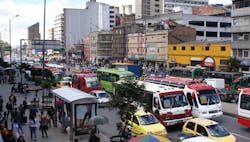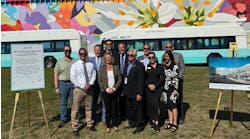In 2011 Bogotá’s ex-Mayor Enrique Peñalosa announced that “An advanced city is not one where the poor can drive around in car but one where the rich use public transport.”
Likewise, the Rio+20 report, the "Future We Want," recognized the importance of the efficient movement of people and goods via access to environmentally sound, safe and affordable public transport systems, as a means to improve urban quality of life and contribute to sustainable development.
Yet and despite this political consensus, Colombia, in 2014, still has no intercity connecting train service, while its capital, Latin America’s sixth largest city, has no tram or metro. This fact is even more surprising given its status as an economic powerhouse, responsible for just under a quarter of the nation's GDP. In fact, Bogotá, together with Kinshasa, of the Democratic Republic of Congo, and Dhaka, Bangladesh, is one of only three cities in the world of more than 7 million people without an urban train service.
What it does have, however, is the world’s busiest bus rapid transit (BRT) system, TransMilenio, transporting 40,000 passengers per direction per hour1 with a daily carrying capacity of more than two million trips. Launched in 2000, and currently in Phase III, Bogotá’s BRT has been steadily incorporated, phase by phase, into an integrated public transport system (IPTS) operated by private companies but planned, regulated and managed by the public entity TransMilenio S.A, on behalf of the city mayor.
The IPTS is composed of 457 routes and services (including feeder services that cover circular routes over roughly a 2.5-mile radius), supported by 144 BRT stations and a fleet that totals more than 8,000 vehicles of articulated, bi-articulated, buses and minibuses. The 698 miles of exclusive BRT lanes that have been constructed, thus far, have contributed to the success of this, a gold standard, BRT system and has led to visits by various international public officials that have come to marvel at and try to emulate the achievements of the TransMilenio.
For all its accolades and official visits however, the BRT and the IPTS have failed to prevent the chaos experienced every rush hour, and beyond that, should it rain, by the 7.74 million packed more densely, in parts, than the citizens of Manhattan. Put simply, the city, following the population explosion in 2004, especially of the neighboring areas2, has outgrown the public transport services that it has on offer. Furthermore, the number of collapses of the public transport system, i.e. where one is forced to either walk or abandon journey prospects, considering only the 13 months the author has lived and worked in the city, is not only on the rise but increasingly noticeable. Every end or start of a working day is accompanied by gridlocked smokescreens and buses filled to the point that a user, due to a lack of mobility and personal space, has to be pulled out by bystanders at bus stops (or streets, in the case of non-IPTS buses) equally desperate to get home or into the office.
More roads to contain traffic is not the answer in a city splitting at the seams. Desperately needed trees to combat the rising levels of car fumes would be felled while the ownership of additional private vehicles encouraged. Public transport in Bogotá needs an overhaul to become more dynamic.
Policies to develop public transport infrastructure and technology need to match the progress of the city — the problem is not the TransMilenio but the fact that the city’s politicians have not responded quick enough to the needs of the people they represent. Take the privately owned minibuses, (some of which do not have a catalyst convertors) that were to be phased out progressively in favor of more organized forms. In the name of fleet efficiency, road safety and environmental improvements the mayor’s office was supposed to have removed these aging and polluting fleets from Bogotá’s streets, at least 12 to 18 months ago. Not only are they still running, in amidst the threat of removal and the obvious disincentive to undergo comprehensive maintenance procedures, they are discharging thick black plumes of smoke on the passerby — exacerbating, not reducing, emissions and respiratory problems. Such signs are, arguably, the most visible consequence of a city at crisis point.
Time more than anything has been the enemy. Political processes and decision making have been slow and this has contributed to the problem rather than the solution. The city has grown beyond the reach of politicians playing catch-up with outdated plans that are continually revised, never to get beyond the blueprint. So what can be done? First, any plans for IPTS expansion need to be consolidated so that action can be taken without further delay. The same can be said for the much-needed metro where quick-fire decisions and acts, based on years of data collection, talks and reports, are essential, if one is to curtail what is becoming a catastrophe. Secondly, the politicians must work hard, under the umbrella of sustainability, to make the city more secure, especially at night, so that people are encouraged to use public transport and the world’s largest network of cycle routes, instead of the car.
Finding a swift resolution to a complex public transport issue may seem a little risky but there is a sense of urgency for those citizens of Bogotá struggling to partake in the most basic aspects of an adult’s life, that is to say arriving on time so to enable productivity at work and getting home earlier enough to appreciate the family. TransMilenio S.A must meet those needs, by using the lessons of the past to move forward.
Kai Whiting, MSc, is a British lecturer and researcher based in Bogotá, Colombia. He is currently the director of the Energy Engineering undergraduate programme and Lead Researcher in Sustainable Energy and Mining at Universidad EAN.
1 Hook, W., 2008. Bus Rapid Transit: An International View. Institute for Transportation and Development Policy. New York.
2 Pardo, C and Alfonso, W (2014) Effect of Urbanisation and Suburbanisation on Health in the Bogotá Region Within Cotte and Pardo, Health, Violence, Environment and Human Development in Developing Countries Nova Science Publishers



